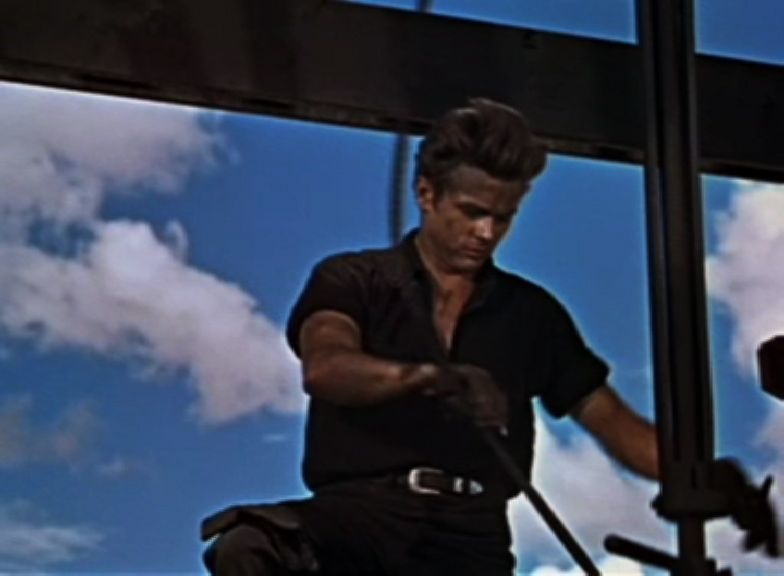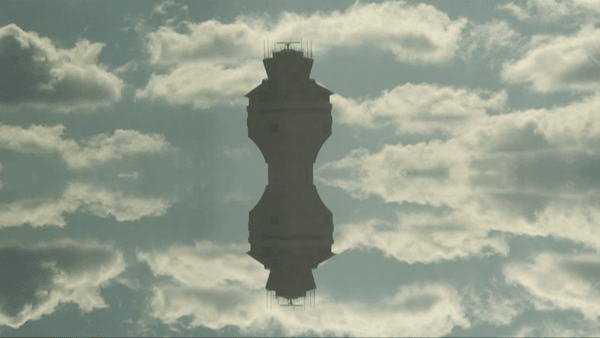CURATED BY SOPHIE JERRAM, JULIAN PRIEST & ANA TERRY
On December 11, 2010 an outdoor screening featuring nine artists was held on the exterior of the Sargeant Gallery as part of the 7th annual ADA Network Symposium: Energetics and Informatics. The symposium focused on the relationship between energy and information in media arts.
Brit Bunkley – Cargo Paradox of Plenty (2010)
Cargo Paradox of Plenty is a dreamscape of environmental and military conflict. The “paradox of plenty” is the paradox of those nations who are rich in natural resources (generally energy resources) often are engaged with energy related conflict. The video begins and ends with natural gas cargo ship, mirrored to appear as if floating as if alien spaceship.
Brit Bunkley has exhibited globally and is in numerous international collections. His practice includes video, 3d digital art work, sculpture, photography and public art. He has received numerous grants and fellowships including a Wallace Trust grant to the Rome Fellowship Prize in the USA. In 2010 he co-curated and participated in the exhibition Hybrids at Auckland’s MIC gallery. He had a solo show at Mary Newton Gallery in Wellington and screened video at several locations including Sanctioned Array-Other2 Specify; White Box gallery NYC, Rencontres Internationales Paris/Berlin/MadridParis at the Centre Pompidou in Paris and Scope Basel in Switzerland.
Hans Ubermorgen -DEEPHORIZON (2010)
Deep Horizon explores the ‘deep ecology’ of coastal Louisiana in the aftermath of the Deepwater Horizon oil spill in the Gulf.
UBERMORGEN.COM is an artist duo created in Vienna, Austria, by lizvlx and Hans Bernhard. Behind UBERMORGEN.COM we can find one of the most unmatchable identities – controversial and iconoclastic – of the contemporary European techno-fine-art avant-garde. Their open circuit of conceptual art, drawing, software art, pixel painting, computer installations, net.art, sculpture and digital activism (media hacking) transforms their brand into a hybrid Gesamtkunstwerk. The computer and the network are (ab)used to create art and combine its multiple forms. the permanent amalgamation of fact and fiction points toward an extremely expanded concept of one’s working materials that for UBERMORGEN.COM also include (international) rights, democracy and global communication (input-feedback loops). “Ubermorgen” is the German word both for “the day after tomorrow” and “super-tomorrow”. http://www.UBERMORGEN.COM
Karen Curley – Licht und Klang (2008)
Licht und Klang is an experimental short film exploration created in an analogue method, without using digital effects to achieve visual results. The film uses oil, water and light in motion, to produce waves of organic patterns and generative structures. In visual terms, the film pays homage to both early 20th century animation pioneers and vintage 60s psychedelic projection displays. However it exhibits a more contemporary minimal aesthetic, with a monotone colour palette driving washes of optical effects and pulsing material vibrations.
Licht und Klang functions primarily as a meditative engagement with pure abstract form, reciprocal energy transfer, pace and light. It also presents viewers with complex geometries, which have been formed by organic materials, perhaps prompting a contemplation of modern production methods and the exploitation of natural resources. In addition it depicts a certain pulsing movement, reminiscent of biological beats, which almost gives the piece a life of its own. The sweeping soundscape accompaniment has been created in real-time using optical sensors which scan light sources in the film as it progresses. Thus a truly synesthetic piece is produced where visual movement literally creates its own synchronised responsive sonic tones and pulsating rhythm.
Karen Curley is a visual artist, interactive designer and experimental filmmaker based in Wellington, NZ. She has a diverse background in philosophy, film studies and multimedia systems and lectures in communication design at Massey University.
Sophie Jerram – Refined Life (2010)
Using recycled film technique mixed with contemporary live action, Refined Life borrows from footage from 1954 film Giant starring James Dean and 1980s television series Dallas. Refined Life was first screened as part of the exhibition, Oil on Troubled Water (Enjoy Gallery Wellington) in which the commodification of water was compared to that of oil. Themes of commodification of feminine adoration and masculine heroism occur as subplots in this examination of resource exploitation.
Sophie Jerram is an artist and independent curator based in Wellington New Zealand. Recent artistic projects include Last Grasp/Siste Grep water intervention; Article Biennial, (Stavanger, Norway, September 2010); the Mud People of Tawharanui for The Tawharanui Open Sanctuary project (New Zealand March 2010), Southern Men on the Rig for The Water Show (Physics Room, Christchurch 2008), as well as Oil on Troubled Water (Enjoy Gallery Wellington 2007) at which Refined Life was first shown.
Curatorial projects include the Letting Space series (co-curated with Mark Amery); www.lettingspace.org.nz
Bombs Away (Physics Room and Adam Art Galleries 2005); Posted Love (National Library of New Zealand touring to 4 venues, 1999).
Sophie is also founder of the Now Future partnership and this year programmed with co-founder Dugal McKinnon a series of inter-disciplinary conversations between artists, business people and scientists on the subject of climate change, called Dialogues with Tomorrow. www.nowfuture.org.nz/dialogues.
Superflex – Burning Car (2007)
Burning Car, the first film by SUPERFLEX, depicts an empty car on fire. Filmed in a single long take, with a deadpan cinematic approach that features smooth panning shots and close-ups, Burning Car plays with the seductive vocabulary of car advertisements. The film can be seen as a response to the riots sweeping through Western Europe in 2005-2007, and media depictions of political unrest. In many ways, it confronts the cheap sensationalism that turned the burning car into a potent symbol for disorder.
Burning Car is produced by Propeller Group (Ho Chi Minh City) and co-produced by De Vleeshal, Middelburg, Nederlands.
Dylan Thomas Herkes – Curse of the Tapeman (2010)
Curse of the Tapeman follows the tragic and mysterious story of a film director who strangles himself with the electromagnetic tape of his own unfinished film. The result is a monster – part man, part tape – unleashed upon the world, whose futuristic corpse remains and duplicates are bought back to life by the scientists at Stink Magnetic Records to currently play as rock and roll three-piece Planet of the Tapes.
Dylan Thomas Herkes is a Christchurch-based filmmaker currently studying at the Ilam school of Fine Arts.
Don Hunter – Carfall (2010)
http://www.youtube.com/watch?v=SmzOgQIk4_c
Carfall is an exploration of the cinematic potential to generate beauty out of images of annihilation through manipulation of speed, repetition and an accompanying sound track. Car chases are synonymous to the ultimate thriller movie – audience exhilaration through speed, winding roads, and a grand climax – the final crash and burn. However through this configuration of samples taken from car-chase film classics such as “The Italian Job” and “Die Another Day”, we are asked to consider the mass consumption of these violent scenarios while, in light of depleting tenuous fuel resources, the crashing cars suggest excessive consumption leading to eventual redundancy.
Don Hunter’s arts practice incorporates a diversity of materials methodologies and delivery mechanisms from collaborations, industrial strength kinetic sculpture, curation, site specific works through to video installations. Projects are developed from a conceptual framework first with emergent materials in a constant state of flux respondent to and informing project direction and ultimate outcome. Don, in collaboration with Ana Terry (Number 8 Collective), was a recipient of the William Hodges Fellowship, a six month residency in Invercargill New Zealand 2008, the pair went onto win the inaugural Platform China Artist Residency in Beijing 2010, and both have just recently been artists-in-residence at Casa Tres Patios in Colombia 2012.
Don’s community of practice has seen him involved in the nationally recognised and funded Blue Oyster Art Space where he was a trustee and played an major role in the gallery relocation and construction in Dunedin, New Zealand, 2005-2007. Don dedicated much time in 2004-2005 planning and constructing Retort Art Space that went on to become an important community arts hub in Dunedin New Zealand. A voluntary position saw Don living and working in Vanuatu where he successfully coordinated the Wan Smolbag International Theatre Festival 2009.
During his Fine Arts study at Otago Polytechnic, Dunedin New Zealand Hunter undertook a highly successful exchange at Utrecht School of the Arts in the Netherlands, where he also exhibited. He went on to be employed as a lecturer at the Otago Polytechnic School of Design. In 2003 Don established Art Crew Ltd a collaborative business providing technical and creative support for artists events and galleries, clients that have included Art Forum Berlin, Biennale of Sydney, the Hocken Gallery, and many individual artists and galleries. From early 2010 to 2012 Don took up an appointment with Whanganui District Council as Arts Coordinator where he was involved in creative capacity building and improving access to, and participation in arts activities within the Whanganui community. Don is currently based in Dunedin as the Dunedin Fringe Festival Production Manager.
Amelia Hitchcock – The Opposite of Green (2009)
The Opposite of Green is a time-lapse animation of one carved apple photographed over three months of atrophy. Like most of Hitchcock’s work, it reflects her concern for our natural environment – growing with the general publics’ media-perpetuated complacency, and recession driven politics, that see the future neglected for meager gains today.
Amelia Hitchcock is currently based in Auckland, at Elam School of Fine Arts as a Summer Research Scholar. She is a first generation New Zealander who has also lived in Japan and England. Amelia has a BFA (Hons) from Elam and her work is primarily inspired by environmental decline witnessed both in NZ and abroad. Hitchcock’s practice is primarily conceptual with a sculptural bent; she utilises a variety of mediums, favouring those that will accurately convey ideas transcending communication boundaries.
Erin Coates – Voyage to Common Wealth (2007)
http://www.youtube.com/watch?v=pMsWRuqmkf0
Voyage to Common Wealth animation is constructed from the miniature images featured on the coins, sourced from countries that are or have historically been a part of the British Empire. The animation charts a cyclical journey, in which time and space are collapsed; a slow pan take us across an ocean into an elaborate landscape, full of bountiful life, opportunity, peril and eventually fantastical chaos. Using imagery taken from everyday currencies, a history of colonisation unfolds, and subsequently unravels. The aesthetic effect of the shimmering silver and gold details against the velvety black can be likened to Chinese lacquered panels, and the work in fact draws on Chinese ‘shanshui’ painting in its perspectival construction and the use of landscape to convey narrative.
Erin Coates is a Perth-based artist and curator. She holds an MFA from the University of British Columbia, Canada, and her artwork has been exhibited in China, Canada, Serbia, Turkey and Australia.



